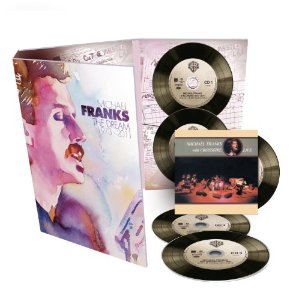Little Richard was an electrifying talent — that we can all agree upon. But where exactly does he stand among contemporaries like Elvis, Jerry Lee Lewis, Buddy Holly and Chuck Berry? Richard, like the other performers mentioned, was an early inductee to the Rock and Roll Hall of Fame. But his legacy has not aged as well as many of his fellow rock giants. Richard did not always have access to the best material. His career quickly stalled out when he announced he would no longer sing “the devil’s music.” Yet, at the top of his game, the man born Richard Penniman could really stir up a room.
Top notch songs like Tutti Frutti, Ready Teddy, Long Tall Sally, Slippin and Slidin, and Rip It Up have surely stood the test of time. Penniman’s producer Art Rupe deserves a great deal of credit — as does the marvelous crew of backing musicians that can be heard on Richard’s New Orleans and Los Angeles recording sessions. These often overlooked studio cats included names like Lee Allen on tenor sax, Huey Smith on piano, Alvin “Red” Tyler on baritone sax, and the legendary Earl Palmer on drums.
Most of the highlights of Little Richard’s early rock n’ roll career can be found on “Here’s Little Richard.” Of special note is the bonus audio interview with Rupe, Richard’s two original demo recordings, and included videos of Penniman’s 1956 Hollywood screen tests. The videos show Little Richard powering his way thru Tutti Frutti and Long Tall Sally. These songs heavily influenced acts like The Beatles and still maintain their energy and excitement more than 50 years after first being transferred to vinyl. The packaging also comes with a tastefully done booklet, some very cool B&W photography, and a fold-out poster of the original album cover. How’s that for extras???
Collectors and longtime fans will really dig the extra features and enhanced sound quality. If you don’t have any Little Richard in your collection, this is a wonderful place to start. Pop it into your CD player and you’ll be “ripping it up” in no time flat. Little Richard had that effect on people — and he still does today.
Rock ’n’ roll may date back to Jackie Brenston’s “Rocket 88” in 1951 and perhaps further to blues/swing hybrids of the 1940s. But many would contend that Little Richard’s “Tutti Frutti,” recorded at Cosimo Matassa’s studio in New Orleans in September 1955, was the first great rock ’n’ roll record. “Tutti Frutti” kicks off Here’s Little Richard, Concord Music Group’s expanded reissue of the original Specialty Records album from 1957. Street date is April 17, 2012.
In addition to the original recordings of Little Richard’s best known hits — “Long Tall Sally,” “Ready Teddy,” “Jenny Jenny,” “Rip It Up,” “Slippin’ and Slidin’” and more — the Concord remastered reissue features two bonus tracks (Specialty demo recordings of “Baby” and “All Night Long”) and two videos (screen tests of “Tutti Frutti” and “Long Tall Sally”).
The set contains liner notes by R&B musicologist Lee Hildebrand, as well as the notes from the original LP. Although Little Richard recorded for RCA Victor in 1951 and Peacock Records in 1953, his Specialty years — the 25-month period between September 1955 and October 1957 — proved monumental. As annotator Hildebrand writes, “They are quite possibly the most exciting and incendiary recordings in the annals of popular music and constitute a body of work upon which Richard’s reputation as one of the primary architects of rock ’n’ roll is measured.” Richard approached Specialty Records at the suggestion of R&B legend Lloyd Price, best known for the 1952 R&B hit “Lawdy Miss Clawdy.”
Richard and his band, the Upsetters, recorded a demo of two blues songs at Macon radio station WMBL-AM. The first, “Baby,” was a blues shuffle, the second a slow blues titled “All Night Long” that featured B.B. King-style guitar by Thomas Hartwell. In fact Specialty owner Art Rupe happened to be looking for a singer like B.B. King, although staff producer Bumps Blackwell recalls Rupe as seeking the next Ray Charles. The demos didn’t overwhelm Rupe, but he signed Little Richard anyway.
Blackwell was assigned to record Richard in New Orleans, and the resulting session featuring pianist Huey Smith and saxophonist Lee Diamond begat eight standard-issue blues/R&B songs. Then, during a break on the second day while Smith was out, the producer heard Richard sing “Tutti Frutti,” accompanying himself on the piano. With only 15 minutes of studio time remaining, and the original lyrics cleaned up by songwriter and studio habitué Dorothy LaBostrie, there was no time for Smith to learn the piano part, so Richard played it himself.
According to Hildebrand, “Richard attacked the piano with incessant even-eight-note patters which was decidedly different from the shuffle rhythm drummer Earl Palmer was laying down behind him. Swing and shuffle beats had been the primary pulse of rhythm & blues until Richard introduced even eights that would come to drive most R&B and rock music and still do today.”
The song shot to #2 on Billboard’s R&B charts and a creditable #17 pop. Rolling Stone rated it at #43 on its list of Greatest 500 Songs of All Time. Subsequent Little Richard Specialty hits dented Top 10 R&B and Top 20 pop. All the songs on Here’s Little Richard were recorded in New Orleans with the exception of “True, Fine Mama” and “She’s Got It,” both made in Los Angeles, Specialty’s home.
Since abruptly giving up show business for God in October 1957, Richard’s life has vacillated between religion and rock ’n’ roll. Today at age 78, he lives in Nashville. Despite being wheelchair-bound, on July 3, 2011, he performed “Tutti Frutti” and other hits on the nationally televised all-star “A Capitol Fourth” on the National Mall in Washington, D.C.
 New topic
New topic Printable
Printable
 Report post to moderator
Report post to moderator








